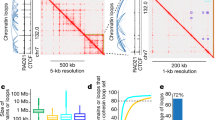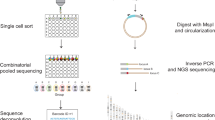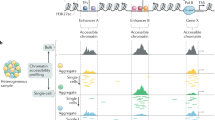Abstract
Chromatin structure is important in transcription regulation. Many factors influencing chromatin structure have been identified, but the transcriptional programs in which they participate are still poorly understood. Chromatin modifiers participate in transcriptional control together with DNA-bound transcription factors. High-throughput experimental methods allow the genome-wide identification of binding sites for transcription factors as well as quantification of gene expression under various environmental and genetic conditions. We have developed a new methodology that uses the vast amount of available data to dissect the contribution of chromatin structure to transcription. We measure and characterize the dependence of transcription factor function on specific chromatin modifiers. We apply our methodology to S. cerevisiae, using a compendium of 170 gene expression profiles of strains defective for chromatin modifiers, taken from 26 different studies. Our method succeeds in identifying known intricate genetic interactions between chromatin modifiers and transcription factors and uncovers many previously unknown genetic interactions, giving the first genome-wide picture of the contribution of chromatin structure to transcription in a eukaryote.
This is a preview of subscription content, access via your institution
Access options
Subscribe to this journal
Receive 12 print issues and online access
$209.00 per year
only $17.42 per issue
Buy this article
- Purchase on Springer Link
- Instant access to full article PDF
Prices may be subject to local taxes which are calculated during checkout





Similar content being viewed by others
References
Harbison, C.T. et al. Transcriptional regulatory code of a eukaryotic genome. Nature 431, 99–104 (2004).
Kurdistani, S.K. & Grunstein, M. Histone acetylation and deacetylation in yeast. Nat. Rev. Mol. Cell Biol. 4, 276–284 (2003).
Tsukiyama, T. The in vivo functions of ATP-dependent chromatin-remodelling factors. Nat. Rev. Mol. Cell Biol. 3, 422–429 (2002).
Eberharter, A. & Becker, P.B. Histone acetylation: a switch between repressive and permissive chromatin. Second in review series on chromatin dynamics. EMBO Rep. 3, 224–229 (2002).
Kadosh, D. & Struhl, K. Repression by Ume6 involves recruitment of a complex containing Sin3 corepressor and Rpd3 histone deacetylase to target promoters. Cell 89, 365–371 (1997).
Swanson, M.J. et al. A multiplicity of coactivators is required by Gcn4p at individual promoters in vivo. Mol. Cell. Biol. 23, 2800–2820 (2003).
Lee, T.I. et al. Transcriptional regulatory networks in Saccharomyces cerevisiae. Science 298, 799–804 (2002).
Stephens, M.A. Use of the Kolmogorov-Smirnov, Cramer-von Mises and related statistics without extensive tables. J. R. Stat. Soc. [Ser A] 32, 115–122 (1970).
Fazzio, T.G. et al. Widespread collaboration of Isw2 and Sin3-Rpd3 chromatin remodeling complexes in transcriptional repression. Mol. Cell. Biol. 21, 6450–6460 (2001).
Goldmark, J.P., Fazzio, T.G., Estep, P.W., Church, G.M. & Tsukiyama, T. The Isw2 chromatin remodeling complex represses early meiotic genes upon recruitment by Ume6p. Cell 103, 423–433 (2000).
Robyr, D. et al. Microarray deacetylation maps determine genome-wide functions for yeast histone deacetylases. Cell 109, 437–446 (2002).
Rubin-Bejerano, I., Mandel, S., Robzyk, K. & Kassir, Y. Induction of meiosis in Saccharomyces cerevisiae depends on conversion of the transcriptional represssor Ume6 to a positive regulator by its regulated association with the transcriptional activator Ime1. Mol. Cell. Biol. 16, 2518–2526 (1996).
Sabet, N., Volo, S., Yu, C., Madigan, J.P. & Morse, R.H. Genome-wide analysis of the relationship between transcriptional regulation by Rpd3p and the histone H3 and H4 amino termini in budding yeast. Mol. Cell. Biol. 24, 8823–8833 (2004).
Clapier, C.R., Langst, G., Corona, D.F., Becker, P.B. & Nightingale, K.P. Critical role for the histone H4 N terminus in nucleosome remodeling by ISWI. Mol. Cell. Biol. 21, 875–883 (2001).
Fazzio, T.G., Gelbart, M.E. & Tsukiyama, T. Two distinct mechanisms of chromatin interaction by the Isw2 chromatin remodeling complex in vivo. Mol. Cell. Biol. 25, 9165–9174 (2005).
Hinnebusch, A.G. Translational regulation of GCN4 and the general amino acid control of yeast. Annu. Rev. Microbiol. 59, 407–450 (2005).
Kuo, M.H., vom Baur, E., Struhl, K. & Allis, C.D. Gcn4 activator targets Gcn5 histone acetyltransferase to specific promoters independently of transcription. Mol. Cell 6, 1309–1320 (2000).
Natarajan, K., Jackson, B.M., Zhou, H., Winston, F. & Hinnebusch, A.G. Transcriptional activation by Gcn4p involves independent interactions with the SWI/SNF complex and the SRB/mediator. Mol. Cell 4, 657–664 (1999).
Hughes, T.R. et al. Functional discovery via a compendium of expression profiles. Cell 102, 109–126 (2000).
Natarajan, K. et al. Transcriptional profiling shows that Gcn4p is a master regulator of gene expression during amino acid starvation in yeast. Mol. Cell. Biol. 21, 4347–4368 (2001).
Keogh, M.C. et al. Cotranscriptional set2 methylation of histone H3 lysine 36 recruits a repressive Rpd3 complex. Cell 123, 593–605 (2005).
Mendizabal, I., Rios, G., Mulet, J.M., Serrano, R. & de Larrinoa, I.F. Yeast putative transcription factors involved in salt tolerance. FEBS Lett. 425, 323–328 (1998).
Wu, J., Suka, N., Carlson, M. & Grunstein, M. TUP1 utilizes histone H3/H2B-specific HDA1 deacetylase to repress gene activity in yeast. Mol. Cell 7, 117–126 (2001).
Smith, R.L. & Johnson, A.D. Turning genes off by Ssn6-Tup1: a conserved system of transcriptional repression in eukaryotes. Trends Biochem. Sci. 25, 325–330 (2000).
Santos-Rosa, H., Bannister, A.J., Dehe, P.M., Geli, V. & Kouzarides, T. Methylation of H3 lysine 4 at euchromatin promotes Sir3p association with heterochromatin. J. Biol. Chem. 279, 47506–47512 (2004).
Grant, P.A. et al. Yeast Gcn5 functions in two multisubunit complexes to acetylate nucleosomal histones: characterization of an Ada complex and the SAGA (Spt/Ada) complex. Genes Dev. 11, 1640–1650 (1997).
Huisinga, K.L. & Pugh, B.F. A genome-wide housekeeping role for TFIID and a highly regulated stress-related role for SAGA in Saccharomyces cerevisiae. Mol. Cell 13, 573–585 (2004).
Bhaumik, S.R. & Green, M.R. Differential requirement of SAGA components for recruitment of TATA-box-binding protein to promoters in vivo. Mol. Cell. Biol. 22, 7365–7371 (2002).
Sterner, D.E., Belotserkovskaya, R. & Berger, S.L. SALSA, a variant of yeast SAGA, contains truncated Spt7, which correlates with activated transcription. Proc. Natl. Acad. Sci. USA 99, 11622–11627 (2002).
Belotserkovskaya, R. et al. Inhibition of TATA-binding protein function by SAGA subunits Spt3 and Spt8 at Gcn4-activated promoters. Mol. Cell. Biol. 20, 634–647 (2000).
Pugh, B.F. Control of gene expression through regulation of the TATA-binding protein. Gene 255, 1–14 (2000).
Chitikila, C., Huisinga, K.L., Irvin, J.D., Basehoar, A.D. & Pugh, B.F. Interplay of TBP inhibitors in global transcriptional control. Mol. Cell 10, 871–882 (2002).
Zhang, L. & Hach, A. Molecular mechanism of heme signaling in yeast: the transcriptional activator Hap1 serves as the key mediator. Cell. Mol. Life Sci. 56, 415–426 (1999).
Raitt, D.C. et al. The Skn7 response regulator of Saccharomyces cerevisiae interacts with Hsf1 in vivo and is required for the induction of heat shock genes by oxidative stress. Mol. Biol. Cell 11, 2335–2347 (2000).
Bahler, J. Cell-cycle control of gene expression in budding and fission yeast. Annu. Rev. Genet. 39, 69–94 (2005).
Basehoar, A.D., Zanton, S.J. & Pugh, B.F. Identification and distinct regulation of yeast TATA box-containing genes. Cell 116, 699–709 (2004).
Hartemink, A.J., Gifford, D.K., Jaakkola, T.S. & Young, R.A. Combining location and expression data for principled discovery of genetic regulatory network models. Pac. Symp. Biocomput., 437–449 (2002).
Gardner, T.S., di Bernardo, D., Lorenz, D. & Collins, J.J. Inferring genetic networks and identifying compound mode of action via expression profiling. Science 301, 102–105 (2003).
Segal, E. et al. Module networks: identifying regulatory modules and their condition-specific regulators from gene expression data. Nat. Genet. 34, 166–176 (2003).
Workman, C.T. et al. A systems approach to mapping DNA damage response pathways. Science 312, 1054–1059 (2006).
Khorasanizadeh, S. The nucleosome: from genomic organization to genomic regulation. Cell 116, 259–272 (2004).
Tanay, A., Steinfeld, I., Kupiec, M. & Shamir, R. Integrative analysis of genome-wide experiments in the context of a large high-throughput data compendium. Mol. Syst. Biol. 2005, 2005.0002 (2005).
Harris, M.A. et al. The Gene Ontology (GO) database and informatics resource. Nucleic Acids Res. 32, D258–D261 (2004).
Shamir, R. et al. EXPANDER–an integrative program suite for microarray data analysis. BMC Bioinformatics 6, 232 (2005).
Bernstein, B.E. et al. Methylation of histone H3 Lys 4 in coding regions of active genes. Proc. Natl. Acad. Sci. USA 99, 8695–8700 (2002).
Bernstein, B.E., Tong, J.K. & Schreiber, S.L. Genomewide studies of histone deacetylase function in yeast. Proc. Natl. Acad. Sci. USA 97, 13708–13713 (2000).
Acknowledgements
We thank A. Tanay for guidance and ideas and all the members of the Kupiec and Shamir laboratories for discussions and encouragement. This work was supported in part by grants from the Israel Science Foundation to M.K. and R.S. and a grant from the Israeli Ministry of Science and Technology to M.K.
Author information
Authors and Affiliations
Corresponding author
Ethics declarations
Competing interests
The authors declare no competing financial interests.
Supplementary information
Supplementary Fig. 1
Complete hierarchical clustering solution for all K-S scores. (PDF 178 kb)
Supplementary Fig. 2
Yap6_(ypd) and Skn7_(h2o2lo) activated genes. (PDF 76 kb)
Supplementary Table 1
The publications from which the gene expression data were obtained. (PDF 37 kb)
Supplementary Table 2
All KS scores. (PDF 1844 kb)
Supplementary Table 3
Unique pairs of TFs and CMs. (XLS 39 kb)
Supplementary Table 4
TATA-containing cohorts. (PDF 19 kb)
Rights and permissions
About this article
Cite this article
Steinfeld, I., Shamir, R. & Kupiec, M. A genome-wide analysis in Saccharomyces cerevisiae demonstrates the influence of chromatin modifiers on transcription. Nat Genet 39, 303–309 (2007). https://doi.org/10.1038/ng1965
Published:
Issue Date:
DOI: https://doi.org/10.1038/ng1965
This article is cited by
-
The histone deacetylase HOS2 controls pathogenicity through regulation of melanin biosynthesis and appressorium formation in Colletotrichum gloeosporioides
Phytopathology Research (2022)
-
Balancing noise and plasticity in eukaryotic gene expression
BMC Genomics (2012)
-
Mcm2 phosphorylation and the response to replicative stress
BMC Genetics (2012)
-
Histone modification pattern evolution after yeast gene duplication
BMC Evolutionary Biology (2012)
-
Distinct role of Mediator tail module in regulation of SAGA-dependent, TATA-containing genes in yeast
The EMBO Journal (2012)



